Sponsored Listings:
The authorities in charge of promoting tourism in Madrid, together with the City Council, hope that more movie cameras can be seen in the city in an effort to promote Madrid as a tourist destination and join the trend of film tourism. This phenomenon, highlighted by the boom of television series, was the reason for 80 million arrivals in 2018, according to TCI Research, and provides cities with visitors whose sole interest is visiting the destinations where their favorite movies and TV shows have been filmed.
“There is a long way to go, but we are clear that cinema and series are increasingly important for cities when being marketed as tourist destinations,” says Almudena Maíllo, responsible for Tourism at the Madrid City Council.
The figures back up the idea that film tourism is a great investment for the city. In 2019, 11,760 applications for filming spaces were processed, a historical record according to data from the City Council. The figure is similar to its rival, Barcelona, which in 2018 (last available reference) received 8,354 applications. Of those in Madrid, only 4,438 (38%) paid fees for 944 different projects, accounting for more than half a million euros, which went into the municipal coffers. According to the consultant Olsberg and Spi, the collection is still far from reaching 5 million, a figure recorded in 2014 in the town of Alnwick, United Kingdom, where the castle that served as the Hogwarts School of Magic in the Harry Potter films is located.
The report also studied the impact on the British economy of seven other film locations, including locations such as Holkham (Shakespeare in Love), Bampton (Downtown Abbey), Lyme Park (Pride and Prejudice) and Puzzlewood (Doctor Who). The results showed an income between 115 and 160 million euros, taking by surprise other European destinations such as Budapest, Barcelona and Madrid who also saw an opportunity in film tourism.
However, in Madrid, there hasn’t been much progress in issuing permits or in bureaucratic procedures for professionals in audiovisual productions. “It is a city that is not yet fully prepared for large filming,” says Néstor Calvo, director of photography of TV shows La valla and Estoy vivo. Calvo has filmed in places such as the United States, Russia, Iceland and Lebanon, so his experience allows him to make a comparison: “In a place with as many people as New York, a filming permit is a matter of a couple of days, while in Madrid it still takes a couple of weeks. We need everything to be faster.”
The possibility of accessing all types of environments is, in the eyes of professionals, one of the main advantages of Madrid. This large diversity of the city convinced Josep Amorós, director of TV series Todo por el juego, that this was the ideal place for his works. In the streets of Madrid he found traces of Argentina, Brazil and even Barcelona.

“The bureaucracy in Madrid has improved greatly in recent years when it comes to filming,” says Amorós. In his case, he tries to be in contact with the Madrid Film Office, an entity dependent on the Culture department whose main mission is to promote filming in the city and, above all, fill it with tourists.
To do this, many travel agencies have come up with pamphlets and brochures describing different cinematographic routes to visitors: from the Madrid found in Pedro Almodóvar’s filmography, to the latest trend that is Madrid as capital of television series, visiting filming locations of shows like Gigantes, Las Chicas Del Cable, Vergüenza, El Ministerio del Tiempo or Paquita Salas.
In fact, each autonomous community has its own office, all working under the Spain Film Office run by Carlos Rosado, which highlights how positive filming has been for the country, in addition to the impact that some scenes of the popular HBO show Games of Thrones were filmed in Spain. “We have great conditions to attract filming. We have everything to capture the attention of tourists and end the dominion of English-speaking countries.”
Source: tourism-review.com










